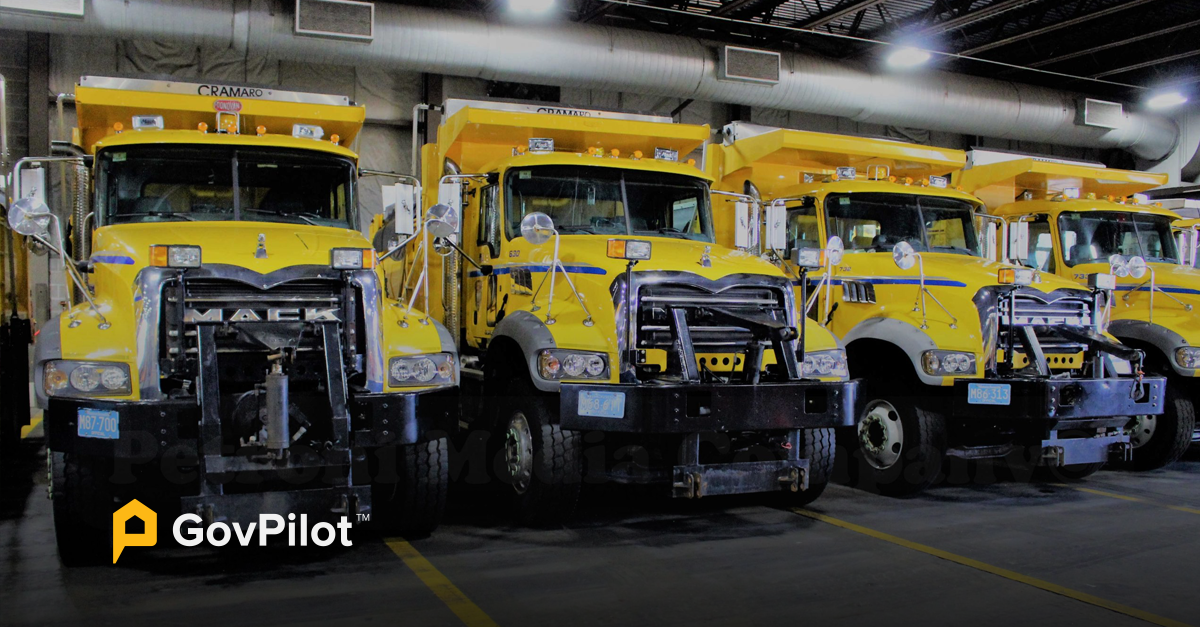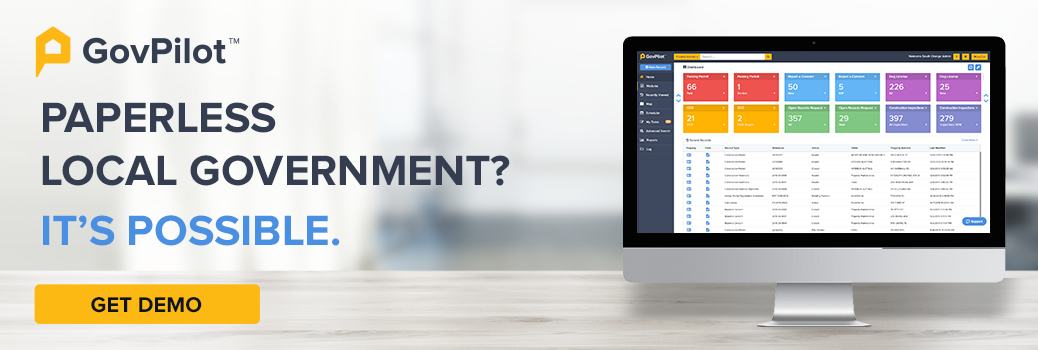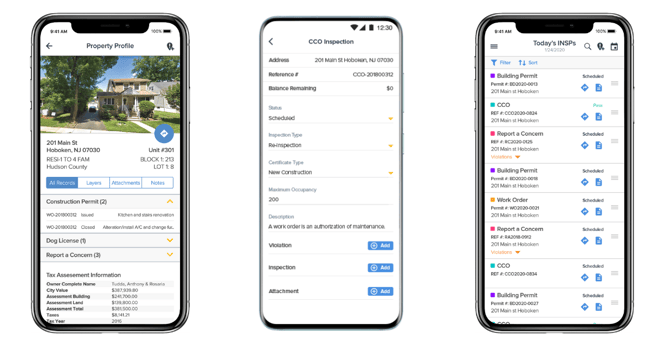Most residents don’t consider what it takes to ensure that their local infrastructure is safe and functional. But a lot goes on behind the scenes of a department of public works. DPW is critical to constructing, maintaining, repairing, and improving local roads, bridges, and other critical government assets.
Public works departments also play an integral role in coordinating emergency responses and extreme weather events. Many employees must remain on-call to respond to critical needs, like repairing traffic lights that have gone out in the middle of the night or clearing snow from roads during a storm. But when public works departments rely on antiquated workflows for scheduling, recording, and filing paperwork, projects can take longer than anticipated and leave infrastructure inoperable or not functioning at max capacity.
Streamlining these internal processes with government software makes employees’ lives easier. In this post, we’ll discuss the many projects and programs you must manage as part of your department of public works strategy. Then, we’ll share details about how to modernize your department and improve workflows with public works technology.
What Does the Local Public Works Department Do?
Departments of public works maintain a community’s infrastructure assets, including roads and buildings. Many DPWs have divisions within them to account for the diverse projects that advance a public works strategy. Common public works management responsibilities include:
- Fleet maintenance: keeping a local government’s fleet (including cars, fire trucks, and police vehicles) operable.
- Stormwater management: directing stormwater from streets and to waterways in an environmentally-responsible manner.
- Engineering: conducting feasibility studies about where buildings and roads can go and how big they can be.
- Building maintenance: ensuring municipal buildings are upkept, including routine maintenance and building system inspections.
- Streets and traffic: maintaining street lights and signs, upkeeping streets through resurfacing, and keeping roads clean of debris through street sweeping.
- Solid waste: conducting a curbside pickup of a community’s waste (for example, trash, recycling, or compost).
In larger municipalities, these divisions might actually be departments all on their own. In smaller communities, however, these activities are often managed by just the public works department. Similarly, a county public works department might differ from a municipal public works department when it comes to the services it provides.
How Your Public Works Department Can Improve Its Processes with Technology
Given the many moving parts that make up a department of public works strategy, it can be challenging to manage projects, ensure critical needs are met, and communicate across divisions. Below we discuss the numerous ways government technology can improve processes within your department to overcome these challenges and move your public works department strategy forward.
Automation of scheduling
Scheduling automation makes it easy for supervisors to create schedules that suit the needs of both employees and the organization. Scheduling software is particularly beneficial in a public works department, given that many roles, like traffic technicians, may need to be on-call or work overtime. Software makes it easier to ensure all shifts are filled and employees aren’t overworked.
Digital work orders
Many public works employees rely on work orders to frame their to-do lists for the day. Digital work orders make it straightforward for staff to communicate these work needs with one another. Additionally, staff in other departments can submit a request for work (such as facility maintenance needs) to public works personnel, who prioritize this work alongside other critical needs.
Timestamps
You can also use technology to track timestamps, such as when a work order is first assigned and when it’s fulfilled. As a result, you can better encourage accountability across your department by seeing who accomplishes what tasks and when. This tool is particularly helpful regarding data tracking and performance management, which we’ll discuss in more detail shortly.
Wondering How to Hold Government Workers Accountable? Here’s further considerations.
Mobile field devices
The vast majority of work in a public works department occurs in the field. A mobile field device makes it much easier to input information while DPW employees are away from their desks. In this way, a mobile field device eradicates duplicate data entry. Additionally, software like GovInspect pairs with mobile technology and enables employees to access critical data, like property information, while in the field.
Digital record storage
Public works departments store a lot of data, from resident records (such as who’s signed up for curbside trash pickup) to when the last time a road was resurfaced or how old a building’s roof is. Cloud-based government data storage keeps all information in one central location and makes it easier to find information efficiently, rather than sorting through physical file folders or relying on the memories of long-time employees.
Learn more about the Benefits of Paperless Governance.
Set recurring tasks
Public works software also makes it easier to set and assign recurring work, so you never forget to complete critical tasks, such as those involved in asset maintenance. For example, you might set recurring tasks to ensure every vehicle in your fleet gets a timely oil change or that all HVAC systems are maintained regularly.
Read more about Local Government Fleet Management Tips.
Digital communications
You can also use technology to streamline communications across all government departments, between divisions, and among supervisors and employees.
Digital government communication tools make it easier for supervisors to maintain connections with staff in the field. This is particularly true for supervisors who must manage employees in multiple locations (for example, a street crew resurfacing a road across town from another team).
Real-time data collection
Another key benefit of public works software is that it can automate real-time data collection. This means busy public works employees don’t need to add another to-do item to their list because data is collected automatically in real time and stored in the government cloud.
GIS maps
Employees can use GIS maps to pinpoint locations of infrastructure that need maintenance, repair, inspections, or other attention across your community. This makes it easy for staff to know precisely where to complete work.
You can also use GIS maps to help citizens, business owners, and executive leadership understand where infrastructure projects are taking place in the community. This is a great way to strengthen relationships with local government business partners and residents.
Financial data tracking
Given the complexity and scope of public works projects, your department likely has a large budget that includes numerous capital items. DPW software makes it easier to manage your budget, including tracking purchase orders, placeholding carryover funds, prioritizing budget requests, and separating operating versus capital needs.
Complaint management software
Last but not least, you can use technology to make it easier for citizens to report issues that affect the public works department. Complaint management software makes it easy for citizens to report on infrastructure issues, such as potholes, downed street signs, and failed power lights, so public works employees can quickly take action to remedy them.
How Does Complaint Management Software Encourage Citizen Engagement? Here’s what to know.
How to Use Public Works Software to Make Data-Driven Decisions
Public works software is a vital component of an effective government performance management strategy. Performance management involves tracking measures, then using that data to determine how to improve programs and projects.
Software streamlines your department of public works strategy by making it easier to track these government key performance indicators since you have a centralized place to collect data for analysis. For example, a management analyst might look at employee time stamps to determine how long it takes to complete certain tasks. Using this information, employees can then make data-driven decisions to improve the efficiency and effectiveness of services.
Improve Your Public Work Department’s Organizational Culture
In addition to using technology to make data-driven decisions and inform government strategic planning efforts in your public works department, you can use GovTech to promote leadership best practices and improve recruitment and retention.
Leadership best practices
A key aspect of outstanding leadership is fostering a culture of trust and employee autonomy. Because technology promotes open communication channels between supervisors and employees, it facilitates trust without the need for micromanagement. Additionally, technology improves communication between divisions, making it easier to think long-term and holistically about department-wide needs. Public works software also makes it easier to maintain appropriate staffing levels without causing employee burnout.
Recruitment and retention
Recruiting and retaining government employees is another modern local government challenge. Public sector organizations can overcome this challenge as part of their municipal public works strategy by providing clear paths toward promotions and advancement. DPW software helps make this possible by efficiently assigning work-related tasks that help employees learn new skills.
By providing employees with opportunities for growth and advancement, you encourage longevity within the organization and create new job opportunities for all members of the community, especially disabled community-members who may seek work from home options . Talented employees know they’re valued, and management knows who they can turn to take on leadership roles within the organization.
Use GovPilot to Modernize Your Public Works Department
Public works software promotes local government innovation, modernizes your department, and makes it easier to serve your community and employees. GovPilot’s public works software provides departments with the benefits we discussed above, so you can actualize your local public works strategy and effectively serve your community.
If you’re excited to learn more about how GovPilot can help your department, don’t hesitate to book a consultation today.
DPW Software FAQs
What is Public Works Software?
Public works software (often known as DPW software) is government technology meant to automate tedious tasks and modernize department of public works workflows.
Key components of DPW software include:
- Digital record storage of all DPW documents, including property records, asset management reports, etc.
- Automated scheduling of inspections, maintenance, and other recurring public works tasks
- Streamlined digital communications between DPW officials and other government departments
- Government data analytics reporting that highlights where public works budgets are being allocated, timelines for projects to get completed, and other key metrics.
How Can Public Works Departments Manage Asset Maintenance?
The DPW is in charge of maintaining public assets like roads, bridges, water utilities infrastructure, etc.
Modern government software expedites this process by automating scheduling of maintenance and inspections and storing related paperwork in an easily accessible digital format.
Read on:
- Continuity of Government: Government Procedures During a Crisis
- Government Cybersecurity: How to Prevent Ransomware Attacks
- Local Government Disaster Preparedness Guide
- Tornado Mitigation & Disaster Plan
- Wildfire Mitigation & Disaster Plan
- Flood Mitigation & Disaster Plan
- Landslide Mitigation & Disaster Plan
- Best Software for Government Procurement
- Municipal Planning: Reclaiming Your City Streets
- Government Fee & Fine Processing: Everything to Know
- Encouraging Civic Engagement at the Local Level
- Government Blockchain: How Local Government Can Use Crypto
- How Local Governments Can Encourage Civic Engagement
- How Do Online Permitting Systems Work?











